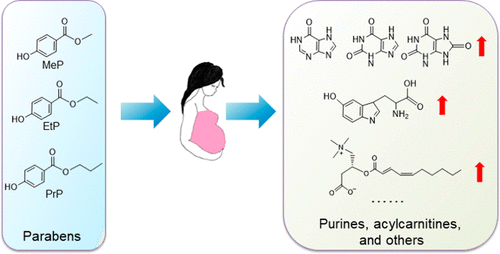当前位置:
X-MOL 学术
›
Environ. Sci. Technol.
›
论文详情
Our official English website, www.x-mol.net, welcomes your feedback! (Note: you will need to create a separate account there.)
Mass Spectrometry-Based Metabolomics Reveals Paraben Exposure Related to Purine Metabolism and Other Pathways.
Environmental Science & Technology ( IF 10.8 ) Pub Date : 2020-02-26 , DOI: 10.1021/acs.est.9b07634 Hongzhi Zhao 1 , Yuanyuan Zheng 1 , Lin Zhu 1 , Li Xiang 1 , Yanqiu Zhou 1 , Jiufeng Li 1 , Jing Fang 1 , Shunqing Xu 2 , Wei Xia 2 , Zongwei Cai 1
Environmental Science & Technology ( IF 10.8 ) Pub Date : 2020-02-26 , DOI: 10.1021/acs.est.9b07634 Hongzhi Zhao 1 , Yuanyuan Zheng 1 , Lin Zhu 1 , Li Xiang 1 , Yanqiu Zhou 1 , Jiufeng Li 1 , Jing Fang 1 , Shunqing Xu 2 , Wei Xia 2 , Zongwei Cai 1
Affiliation

|
Parabens are widely used as common preservatives in pharmaceutical and cosmetic industries. Exposure to parabens has been found to be associated with metabolic alterations of human and the increased risk of metabolic disease, such as diabetes. However, limited information is available about metabolic pathways related to paraben exposure. In this study, three parabens were determined in the urine samples of 88 pregnant women by using ultra-high performance liquid chromatography coupled with triple quadrupole mass spectrometry (UHPLC-QqQ MS). The samples were divided into different groups based on tertile distribution of urinary paraben concentrations. Metabolic profiling of the 88 urine samples was performed by using UHPLC coupled with Orbitrap high-resolution MS. Differential metabolites were screened by comparing the profiles of urine samples from different paraben exposure groups. The identified metabolites included purines, acylcarnitines, etc, revealing that metabolic pathways such as purine metabolism, fatty acid β-oxidation and other pathways were disturbed by parabens. Eighteen and three metabolites were correlated (Spearman correlation analysis, p < 0.05) with the exposure levels of methyparaben and propylparaben, respectively. This is the first MS-based non-targeted metabolomics study on pregnant women with paraben exposure. The findings reveal the potential health risk of exposure to parabens and might help understand the link between paraben exposure and some metabolic disease.
中文翻译:

基于质谱的代谢组学揭示了与嘌呤代谢和其他途径有关的对羟基苯甲酸酯暴露。
对羟基苯甲酸酯被广泛用作制药和化妆品行业的常用防腐剂。已经发现对羟基苯甲酸酯的暴露与人的代谢改变和代谢疾病(例如糖尿病)的风险增加有关。但是,关于与对羟基苯甲酸酯接触有关的代谢途径的信息有限。在这项研究中,使用超高效液相色谱结合三重四极杆质谱(UHPLC-QqQ MS)在88名孕妇的尿液样品中测定了三种对羟基苯甲酸酯。根据尿对羟基苯甲酸酯浓度的三分分布将样品分为不同的组。通过使用UHPLC和Orbitrap高分辨率质谱联用对88个尿液样品进行代谢谱分析。通过比较来自不同对羟基苯甲酸酯暴露组的尿液样品的特征筛选差异代谢物。鉴定出的代谢产物包括嘌呤,酰基肉碱等,表明代谢途径如嘌呤代谢,脂肪酸β-氧化等途径受到对羟基苯甲酸酯的干扰。十八种和三种代谢物分别与甲基对羟基苯甲酸酯和对羟基苯甲酸丙酯的暴露水平相关(Spearman相关分析,p <0.05)。这是针对对羟基苯甲酸酯暴露的孕妇的首次基于MS的非靶向代谢组学研究。这些发现揭示了暴露于对羟基苯甲酸酯的潜在健康风险,并可能有助于理解对羟基苯甲酸酯暴露与某些代谢性疾病之间的联系。这表明对羟基苯甲酸酯会干扰嘌呤代谢,脂肪酸β-氧化等代谢途径。十八种和三种代谢物分别与甲基对羟基苯甲酸酯和对羟基苯甲酸丙酯的暴露水平相关(Spearman相关分析,p <0.05)。这是针对对羟基苯甲酸酯暴露的孕妇的首次基于MS的非靶向代谢组学研究。这些发现揭示了暴露于对羟基苯甲酸酯的潜在健康风险,并可能有助于理解对羟基苯甲酸酯暴露与某些代谢性疾病之间的联系。这表明对羟基苯甲酸酯会干扰嘌呤代谢,脂肪酸β-氧化等代谢途径。十八种和三种代谢物分别与甲基对羟基苯甲酸酯和对羟基苯甲酸丙酯的暴露水平相关(Spearman相关分析,p <0.05)。这是针对对羟基苯甲酸酯暴露的孕妇的首个基于MS的非靶向代谢组学研究。这些发现揭示了暴露于对羟基苯甲酸酯的潜在健康风险,并可能有助于理解对羟基苯甲酸酯暴露与某些代谢性疾病之间的联系。这是针对对羟基苯甲酸酯暴露的孕妇的首次基于MS的非靶向代谢组学研究。这些发现揭示了暴露于对羟基苯甲酸酯的潜在健康风险,并可能有助于理解对羟基苯甲酸酯暴露与某些代谢性疾病之间的联系。这是针对对羟基苯甲酸酯暴露的孕妇的首次基于MS的非靶向代谢组学研究。这些发现揭示了暴露于对羟基苯甲酸酯的潜在健康风险,并可能有助于理解对羟基苯甲酸酯暴露与某些代谢性疾病之间的联系。
更新日期:2020-03-06
中文翻译:

基于质谱的代谢组学揭示了与嘌呤代谢和其他途径有关的对羟基苯甲酸酯暴露。
对羟基苯甲酸酯被广泛用作制药和化妆品行业的常用防腐剂。已经发现对羟基苯甲酸酯的暴露与人的代谢改变和代谢疾病(例如糖尿病)的风险增加有关。但是,关于与对羟基苯甲酸酯接触有关的代谢途径的信息有限。在这项研究中,使用超高效液相色谱结合三重四极杆质谱(UHPLC-QqQ MS)在88名孕妇的尿液样品中测定了三种对羟基苯甲酸酯。根据尿对羟基苯甲酸酯浓度的三分分布将样品分为不同的组。通过使用UHPLC和Orbitrap高分辨率质谱联用对88个尿液样品进行代谢谱分析。通过比较来自不同对羟基苯甲酸酯暴露组的尿液样品的特征筛选差异代谢物。鉴定出的代谢产物包括嘌呤,酰基肉碱等,表明代谢途径如嘌呤代谢,脂肪酸β-氧化等途径受到对羟基苯甲酸酯的干扰。十八种和三种代谢物分别与甲基对羟基苯甲酸酯和对羟基苯甲酸丙酯的暴露水平相关(Spearman相关分析,p <0.05)。这是针对对羟基苯甲酸酯暴露的孕妇的首次基于MS的非靶向代谢组学研究。这些发现揭示了暴露于对羟基苯甲酸酯的潜在健康风险,并可能有助于理解对羟基苯甲酸酯暴露与某些代谢性疾病之间的联系。这表明对羟基苯甲酸酯会干扰嘌呤代谢,脂肪酸β-氧化等代谢途径。十八种和三种代谢物分别与甲基对羟基苯甲酸酯和对羟基苯甲酸丙酯的暴露水平相关(Spearman相关分析,p <0.05)。这是针对对羟基苯甲酸酯暴露的孕妇的首次基于MS的非靶向代谢组学研究。这些发现揭示了暴露于对羟基苯甲酸酯的潜在健康风险,并可能有助于理解对羟基苯甲酸酯暴露与某些代谢性疾病之间的联系。这表明对羟基苯甲酸酯会干扰嘌呤代谢,脂肪酸β-氧化等代谢途径。十八种和三种代谢物分别与甲基对羟基苯甲酸酯和对羟基苯甲酸丙酯的暴露水平相关(Spearman相关分析,p <0.05)。这是针对对羟基苯甲酸酯暴露的孕妇的首个基于MS的非靶向代谢组学研究。这些发现揭示了暴露于对羟基苯甲酸酯的潜在健康风险,并可能有助于理解对羟基苯甲酸酯暴露与某些代谢性疾病之间的联系。这是针对对羟基苯甲酸酯暴露的孕妇的首次基于MS的非靶向代谢组学研究。这些发现揭示了暴露于对羟基苯甲酸酯的潜在健康风险,并可能有助于理解对羟基苯甲酸酯暴露与某些代谢性疾病之间的联系。这是针对对羟基苯甲酸酯暴露的孕妇的首次基于MS的非靶向代谢组学研究。这些发现揭示了暴露于对羟基苯甲酸酯的潜在健康风险,并可能有助于理解对羟基苯甲酸酯暴露与某些代谢性疾病之间的联系。














































 京公网安备 11010802027423号
京公网安备 11010802027423号